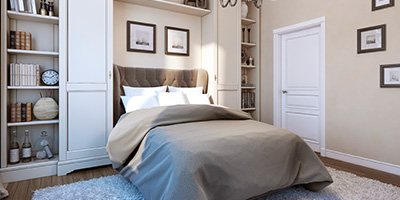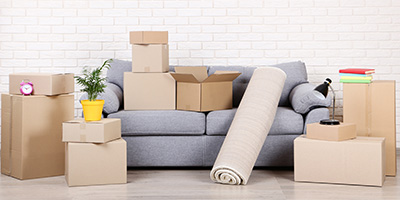9 Easy Basement Organization Ideas to Use This Weekend

Easy Ways to Organize a Basement
Basements, both finished and unfinished, tend to become the catch-all storage area for everything from holiday decorations to that old Singer sewing table you inherited from your parents. Keeping a few odds and ends downstairs isn’t an issue. But when stacks of boxes start disappearing behind other stacks of boxes, you may have a clutter problem.
Fortunately, decluttering your basement doesn’t have to drag on for weeks on end. We’ll show you how to organize with helpful storage ideas that will keep your space clean for good.
Tips for Starting a Basement Organization Project
According to Dionne Myhre of Home Made Our Way, you should start this project by removing everything from your basement and inspecting the space for mold, leaks or any evidence of pests. If you aren’t sure exactly what to look for, hire a home inspector. If any issues are spotted, make sure they are taken care of before putting your belongings back.
Your basement can hold a lot things, but one thing you don’t want in it is any kind of standing water or moisture. Before you get working, know the signs your basement needs waterproofing and learn how to get it done correctly.
4 Ways to Organize a Finished Basement
1. Get Rid of Junk You Don’t Need
Before beginning your basement organization project, declutter and purge all the items you no longer need or want. We recommend using the Three-Box Method and sorting items into “Keep,” “Get Rid Of” or “Put In Storage” boxes.
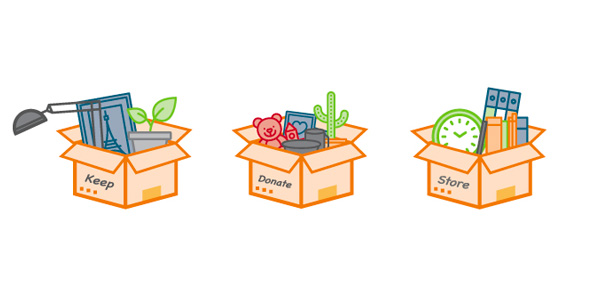
Items that fall into your “Keep” category can be put away in their designated home if that already exists. Otherwise, make a plan for where they’ll be kept while you’re organizing the basement.
Anything you decide to get rid of should be immediately removed from the basement, and either donated, recycled or thrown away.
For the items you intend to put in storage, you can use clearly-labeled plastic bins and sort by category or season so they are easy to track down when you need them.

“Often what is in our basements we have already started to distance ourselves from. Keep seasonal items that you do rotate in and out. Keep clothes that your children will grow into (not the ones they have already grown out of!) and supplies for activities.”
Nettie Owens, Sappari Solutions
2. Choose a Specific Purpose for the Space
To make the most of your square footage, you should decide if you’ll be designating your finished basement as a guest suite, kids’ playroom or media room. Even if your basement is only half-finished and you’re working with a smaller space, make sure to designate it for a specific use so it doesn’t become a catch-all for things that need a home.

“When designing a finished basement, create areas for built-in shelving, closets and cabinets to store board games, craft supplies and hidden storage.”
Kristin Vander Wiede, Livable Solutions Professional Organizing
3. Create Built-In Storage Options
Once the purpose of your space is decided, pick furniture that allows for extra storage. Since your finished basement will be used as additional living space, you not only want to keep things organized, but also looking nice.
If you’re using the basement as a living room, consider getting a storage ottoman to hold blankets and an entertainment center with shelves and drawers. For a guest suite, look into wardrobes for visitors’ belongings and platform storage beds. As a playroom, your basement should be equipped with bookshelves, baskets and a toy chest so everything can be put away in a designated space. Regardless of how you’re using the space, installing shelving in the basement is useful for storing any odds and ends that find their way downstairs.

“Choose furniture and shelving that provide hidden storage options such as storage ottomans, shelving with baskets and media centers with drawers or cabinets.”
Kristin Vander Wiede, Livable Solutions Professional Organizing
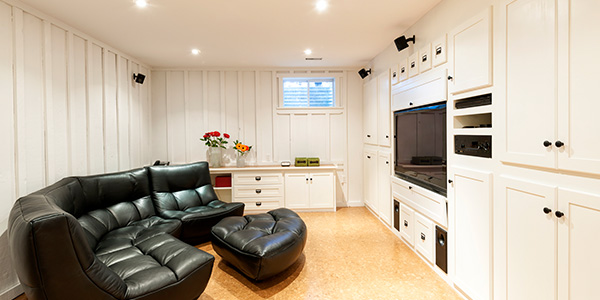
4. Utilize Extra Areas
Another basement storage idea to consider is utilizing the extra space under your stairs. If it’s available to you, you can make the most of this storage area by adding floating shelves or cubbies for better organization. If your basement is equipped with built-in wall shelving, you can install a sliding barn door to conceal the shelves for a cleaner appearance and to add aesthetic to the room.
5 Ways to Organize an Unfinished Basement
1. Opt for Vertical Storage
One of the most popular basement organization tips for a finished or unfinished basement is to utilize vertical storage as much as possible. This can be done in a number of ways, from installing wall shelving units to using peg boards or heavy-duty hooks for hanging items from the ceiling. Keeping things off the ground not only helps with saving space, but can also save your items from water damage if the basement ever floods.

“Maximize vertical storage space with tall shelving. Pick or build shelving that is uniform to create a more orderly look and maximize the storage capacity of your available wall space. Use pegboards and hooks to create a visual area to store small tools you may grab often.”
Kristin Vander Wiede, Livable Solutions Professional Organizing
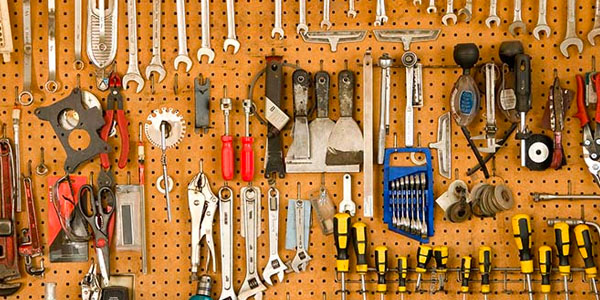
2. Store Items in Airtight Containers
Since moisture can be an issue in many basements, skip the cardboard boxes and go with airtight plastic containers. They will be easier to label and move around – plus they’ll look neater on your shelves.

“Purchase water-proof containers and avoid cardboard boxes at all costs. One busted pipe can wipe out stored items like photos, important papers, and documents, as well as clothing.”
Dionne Myhre, Home Made Our Way
3. Repurpose Old Cabinets
If you’ve recently remodeled your kitchen or have access to old cabinets, repurposing them for your unfinished basement is a great way to add storage. You can hang some above your washer and dryer to organize laundry supplies, or use them to conceal storage bins and other miscellaneous items.
4. Zone and Label Everything
Divide your basement into zones and tackle them one by one. Continue using the Three-Box Method to categorize the items from each zone and get them organized. Once you’ve determined everything you’re going to keep, decide if they will go into containers, be hung up or relocated.

“When it comes to arranging your items, make sure to place hardly-used items toward the back and often-used in the front.”
Dionne Myhre, Home Made Our Way
Clearly labeling containers and keeping all of your items in their designated zones will help keep your basement organized over time.

“In an unfinished basement, sturdy shelving and clear bins are the way to go. Bonus points for shelving on casters that lock into place. Double check that the bins you have selected will fit on the shelving. Shelves will keep you from stacking bins one on top of another and creating a situation that is hard to maintain.”
Nettie Owens, Sappari Solutions
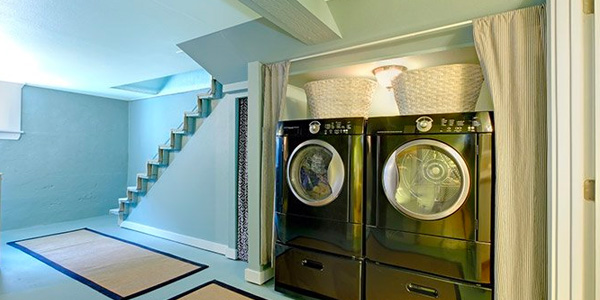
5. Designate a Specific Space for Laundry
If your washer and dryer are located in the basement, make sure to designate a zone specifically for laundry purposes. You can store your soap and other cleaning supplies inside cabinets if you have ones to reuse, or you can add wall shelving. You may also want to have a flat, clear space for folding clothes and a rack for clothing that needs to be air-dried.
Tired of concrete floors and walls? Learn How to Finish a Basement From Floor to Ceiling.
Basement Organization Tips to Keep Things in Order for Good
Once your basement is organized, it’ll feel like a weight has been lifted off your shoulders… until a few weeks pass and you notice things start to get moved out of place again. According to Kristin Vander Wiede of Livable Solutions Professional Organizing, you should clean your basement out every fall and spring to avoid too much clutter being built back up over time.
Using smart storage solutions with clearly labeled containers is essential for staying organized and will make it easier to put items back where they belong consistently.

